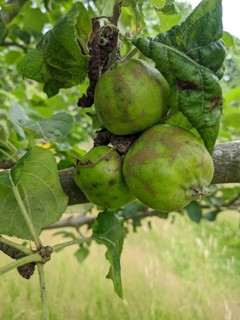
This is a guest blog written by Rich Fenn-Griffin, Assistant Gardens Manager at Loughborough University.
Sometimes it can often seem like the apple trees just take care of themselves. All I need to do is a bit of judicious pruning in the winter, perhaps a feed or two to help fruit development, and then merely reaping a hopefully bountiful harvest in the autumn. Well, no. July is a busy time in the Fruit Route Orchards with apple thinning taking place. So, why thin them?
To control pests
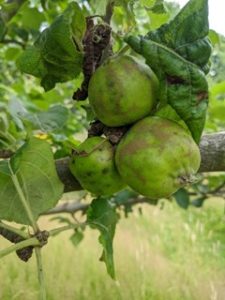 Thinning allows me to inspect the fruit on the trees and get rid of diseased or insect riddled ones. This helps to keep the good fruit healthy by reducing the disease reservoirs. Brown rot is first on my list and not only completely spoils the fruit but has the potential to spread to neighbouring good fruit. These apples are easily identified as having turned brown, soft and possessing concentric rings of yellowish mould on the surface. I remove these apples and carry them well away from the site to be disposed of. I also wash my hands between handling them and the good apples so as not to spread the infection.
Thinning allows me to inspect the fruit on the trees and get rid of diseased or insect riddled ones. This helps to keep the good fruit healthy by reducing the disease reservoirs. Brown rot is first on my list and not only completely spoils the fruit but has the potential to spread to neighbouring good fruit. These apples are easily identified as having turned brown, soft and possessing concentric rings of yellowish mould on the surface. I remove these apples and carry them well away from the site to be disposed of. I also wash my hands between handling them and the good apples so as not to spread the infection.
Apples, unsurprisingly, have many insect pests. However, it doesn’t always right-off the fruit. Unless stated, all the unripe or damaged fruit from thinning can be saved and is used (I will tell you how later on).
My first insect pest contenders are wasps and earwigs, both of whom nibble areas of the fruit (particularly if the surface is already damaged). However, I am ambivalent about getting rid of these fruits. If I throw the damaged apples away, it means these bugs might just move onto fruit not damaged, but equally, if I don’t throw them away I might be supporting a population of these hungry bugs that come back for more. On balance, I tend to leave them believing them even wasps and earwigs have a right to share in the crop.
Apple sawfly and codling moth are a bigger problem. Both insects bore into the fruit and feed on the central core. The sawfly infested apples tend to get less noticed because these usually drop off the tree before thinning, but the codling moth affected fruits will remain till harvest and will be unpleasant when opened up. I remove most of these from the orchard and dispose of them off-site. This means I maintain a small codling moth population but essentially control how much damage it can reek on the orchard (everything has a place in the world).
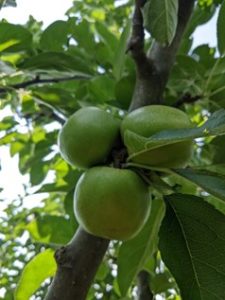
Lastly, apple rhynchites (see fig 1) are small brown weevils that produce numerous small holes over the surface of the fruit. These holes tend to blacken and are sunken on the fruits surface. The fruit doesn’t look pleasant, but the flesh is actually fine. I will leave these apples on the tree unless there’s another reason (given below) for removing them as they can still be used (even if they don’t look that pleasant).
Fruit size and shape
Perhaps the most important reason for thinning is that this allows you to control fruit size and shape. If I don’t thin the apples, then they’ll just be a lot of diddly misshapen apples. As most people prefer a reasonable sized and good-looking apple, this is what I aim for. Usually I thin the fruit (using secateurs as twisting can make good fruit drop off) to three on each truss (figure 2). However, this is not a hard rule as some I take down to two or even one. This depends on the general health of the tree, how much fruit it has for its size and the current size of that fruit. For instance, aphids have run riot in the orchard this year. For some of the smaller trees, I have reduced the apples to one per truss. This will mean less, but bigger fruit. Shape is also an important consideration. If, the apples are very tightly packed together on the truss they may become misshapen as they develop. Removing one to create some movement for the others will allow appetising apples to develop. I am ruthless in my thinning because I now later it will pay dividends.
Getting up close and personal
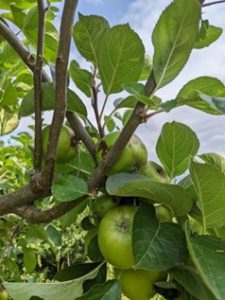 Although, not directly about the fruit, thinning allows me to really get to know our apple trees. When I’m looking over the University trees, I’m asking myself whether they look healthy? Are there any signs of disease? Have I got suckers that need removing? What does the branch structure look like? Can I see some pruning jobs that need doing later in the year – particularly as I can see the way the fruit hangs on the branches? How bad are leaf and shoot problems? Are there any serious problems that need to be dealt with and are there anyways to encourage natural predators? On the fruit thinning and branch structure front, I note where apples are rubbing against branches and remove them. In figure 3, we have two trusses with three fruits and one with one. I removed the one fruited truss and two out of the three fruited truss as the apples were rubbing against the branches (shown by the brown bruising on the fruit). This allows the remaining fruit more freedom to develop and has removed damaged fruit that may well become diseased before harvest (ruining neighbouring apples).
Although, not directly about the fruit, thinning allows me to really get to know our apple trees. When I’m looking over the University trees, I’m asking myself whether they look healthy? Are there any signs of disease? Have I got suckers that need removing? What does the branch structure look like? Can I see some pruning jobs that need doing later in the year – particularly as I can see the way the fruit hangs on the branches? How bad are leaf and shoot problems? Are there any serious problems that need to be dealt with and are there anyways to encourage natural predators? On the fruit thinning and branch structure front, I note where apples are rubbing against branches and remove them. In figure 3, we have two trusses with three fruits and one with one. I removed the one fruited truss and two out of the three fruited truss as the apples were rubbing against the branches (shown by the brown bruising on the fruit). This allows the remaining fruit more freedom to develop and has removed damaged fruit that may well become diseased before harvest (ruining neighbouring apples).
What do I do with all these unripe apples?
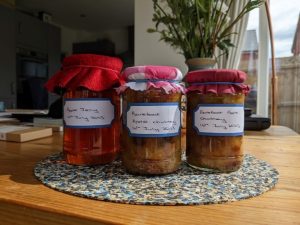 I probably remove somewhere between 40 – 50% of the apples from the orchards in the thinning and end up with trug fulls of unripe apples. This might initially seem like a waste, but all these apples can be used (our ancestors never let anything go to waste). Generally, when selecting recipes to use up the fruit I treat the large unripe apples as cooking apples and the smaller unripe ones as crab apples. For small unripe apples I’ve made apple jelly, apple cheese, and pickled apples. For the larger ones, I make any apple chutney recipes or just simply use them for fruit crumbles or pies.
I probably remove somewhere between 40 – 50% of the apples from the orchards in the thinning and end up with trug fulls of unripe apples. This might initially seem like a waste, but all these apples can be used (our ancestors never let anything go to waste). Generally, when selecting recipes to use up the fruit I treat the large unripe apples as cooking apples and the smaller unripe ones as crab apples. For small unripe apples I’ve made apple jelly, apple cheese, and pickled apples. For the larger ones, I make any apple chutney recipes or just simply use them for fruit crumbles or pies.
However, I am still left with a lot of very small fruit, fruit that doesn’t look appetising or just simply I haven’t got the time to process. For this, we are building a relationship with a local pig farmer and they are sorting out the rest. Waste nothing!


